Three-point fixation technique gives more secure anchorage to scleral sutured IOLs
Sutures are tied to three points of the IOL haptics and fixed to the sclera at 3, 5 and 9 o’clock.
NAPLES, Italy – Three-point fixation helps prevent major complications of scleral fixation of IOLs, according to Giorgio Beltrame, MD. He and colleagues at San Donà di Piave Eye Clinic, Italy, have successfully applied the technique in 31 cases of secondary IOL implantation.
“When there is no capsular support, the two-point fixation to the sclera is not sufficient to stabilize the IOL,” said Dr. Beltrame. “The lens tends to rotate on these two points and therefore tends to tilt, to become decentered and produce bleeding into the anterior chamber. With an additional point of anchorage, all these undesirable movements are avoided.” He presented a poster here at the meeting of the Italian Ophthalmologic Society.
Three scleral flaps
The procedure starts with a partial fornix-based conjunctival peritomy, carried out under peribulbar anesthesia. Then three small triangular limbal-based scleral flaps of about one-third scleral thickness are created at 3, 5 and 9 o’clock.
A 6-mm-wide and 3.5-mm-long scleral tunnel is performed in the 12-o’clock position. The aqueous humor flows out of the tunnel and sodium hyaluronate solution is then injected. If necessary, anterior vitrectomy is also carried out.
For implantation, Dr. Beltrame uses 13.5-mm posterior chamber IOLs with biconvex 6.5-mm PMMA optics and PMMA loops with positioning holes (Bausch & Lomb UV absorbing PMMA IOL).
“Three looped 10-0 polypropylene sutures (Alcon Laboratories) are tied to the two holes and at the base of one of the IOL loops. One by one, the needles are then inserted into the scleral tunnel, the pupil and the ciliary sulcus, and brought out through the sclera, posterior to the limbus, corresponding to the three triangular openings. This procedure is performed first at 9 o’clock, then repeated at 5 and 3 o’clock, to prevent crossing of the sutures,” Dr. Beltrame said.
The IOL loop tied to only one suture is then inserted through the scleral tunnel and the pupil and positioned at the back of the iris, at 9 o’clock. When the suture is pulled from outside at the 9 o’clock end, the loop slides into the ciliary sulcus. Then, pulling the 5 and 3 o’clock sutures, the optic and the second loop fall into position.
“A gentle, gradual traction on the sutures is very important to prevent crossing and accidental falling of the lens into the vitreous chamber. Also, it is important that the third suture at the base of the haptic is not tied too tightly to the loop, as it would pull the lens downward,” Dr. Beltrame said
The three sutures are finally fixed to the sclera, first at 9 o’clock, then at 3 and 5 o’clock, to secure the lens to the ciliary sulcus. The scleral flaps are also sutured with 10-0 Vicryl. The viscoelastic is aspirated, the anterior chamber is refilled with balanced salt solution and the scleral tunnel is closed with 10-0 Vicryl. The conjunctiva is then cauterized, Dr. Beltrame explained.
“In this way, the IOL is kept perpendicular to the visual axis. The third suture at the base of the haptic holds the lens and prevents it from tilting,” he said.
In a more recent variation of the technique, the scleral flaps are not sutured. They are held into position by the conjunctiva, which is anchored to the limbus by two sutures.
Successful implants
From April 1998 to December 2000, 31 aphakic eyes of 26 patients underwent secondary IOL implantation with the three-point procedure. Nine were female, aged 45 to 76 years and 17 were male, ranging from 12 to 82 years of age. Of the total number of eyes, 18 had undergone intracapsular cataract extraction and 13 had experienced posterior capsule rupture in the course of extracapsular cataract extraction or phacoemulsification.
“In 11 eyes we had to perform anterior vitrectomy, but surgery was nevertheless successful in all cases. We had no postoperative complications in 29 eyes. One patient presented a mild hyphema, which disappeared in 5 days, and another patient had a mild corneal edema, which responded well to local corticosteroid therapy. In all cases, the IOL was well centered and stable,” Dr. Beltrame said.
All patients maintained or increased visual acuity in the postoperative period: mean best corrected visual acuity was 20/25, ranging between 20/32 and 20/20. The mean follow-up was 12 months (range 6 to 12).
“Compared with other three-point fixation techniques, our procedure has demonstrated to be easier and safer,” said Dr. Beltrame. “No specially-designed IOL is needed and sutures are more precisely secured through the ciliary sulcus, as we perforate the sclera from the inside to the outside. The technique is also rapidly carried out. It only takes 3 to 4 minutes more than a standard procedure to create the 5 o’clock flap, to position and pull the third suture and to close the flap. The use of looped sutures is recommended for faster engagement of the IOL.”


Three limbal-based scleral flaps are created at 3, 5 and 9 o’ clock.
The scleral tunnel is at the 12-o’clock position.
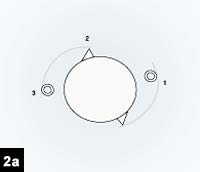
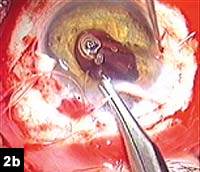
The three points of fixation on the IOL haptics are shown in the illustration.
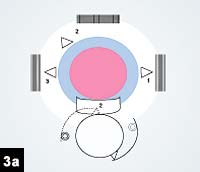

The needles are inserted and brought out through the sclera at the locations
of the three flaps.

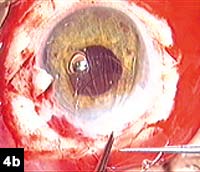
The IOL is positioned by pulling and tightening the sutures.
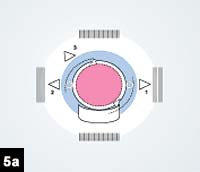

The IOL is fixed to the sclera at three points, preventing rotation, tilting or
decentration.
For Your Information:
- Giorgio Beltrame, MD, is head of the San Donà di Piave Eye Clinic. He can be reached at e-mail: gdriuss@tin.it. Dr. Beltrame has no direct financial interest in the products mentioned in this article nor is he a paid consultant for any companies mentioned.
